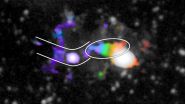(Press-News.org) A team of astronomers led by Caltech has discovered a giant swirling disk of gas 10 billion light-years away--a galaxy-in-the-making that is actively being fed cool primordial gas tracing back to the Big Bang. Using the Caltech-designed and -built Cosmic Web Imager (CWI) at Palomar Observatory, the researchers were able to image the protogalaxy and found that it is connected to a filament of the intergalactic medium, the cosmic web made of diffuse gas that crisscrosses between galaxies and extends throughout the universe.
The finding provides the strongest observational support yet for what is known as the cold-flow model of galaxy formation. That model holds that in the early universe, relatively cool gas funneled down from the cosmic web directly into galaxies, fueling rapid star formation.
A paper describing the finding and how CWI made it possible currently appears online and will be published in the August 13 print issue of the journal Nature.
"This is the first smoking-gun evidence for how galaxies form," says Christopher Martin, professor of physics at Caltech, principal investigator on CWI, and lead author of the new paper. "Even as simulations and theoretical work have increasingly stressed the importance of cold flows, observational evidence of their role in galaxy formation has been lacking."
The protogalactic disk the team has identified is about 400,000 light-years across--about four times larger in diameter than our Milky Way. It is situated in a system dominated by two quasars, the closest of which, UM287, is positioned so that its emission is beamed like a flashlight, helping to illuminate the cosmic web filament feeding gas into the spiraling protogalaxy.
Last year, Sebastiano Cantalupo, then of UC Santa Cruz (now of ETH Zurich) and his colleagues published a paper, also in Nature, announcing the discovery of what they thought was a large filament next to UM287. The feature they observed was brighter than it should have been if indeed it was only a filament. It seemed that there must be something else there.
In September 2014, Martin and his colleagues, including Cantalupo, decided to follow up with observations of the system with CWI. As an integral field spectrograph, CWI allowed the team to collect images around UM287 at hundreds of different wavelengths simultaneously, revealing details of the system's composition, mass distribution, and velocity.
Martin and his colleagues focused on a range of wavelengths around an emission line in the ultraviolet known as the Lyman-alpha line. That line, a fingerprint of atomic hydrogen gas, is commonly used by astronomers as a tracer of primordial matter.
The researchers collected a series of spectral images that combined to form a multiwavelength map of a patch of sky around the two quasars. This data delineated areas where gas is emitting in the Lyman-alpha line, and indicated the velocities with which this gas is moving with respect to the center of the system.
"The images plainly show that there is a rotating disk--you can see that one side is moving closer to us and the other is moving away. And you can also see that there's a filament that extends beyond the disk," Martin says. Their measurements indicate that the disk is rotating at a rate of about 400 kilometers per second, somewhat faster than the Milky Way's own rate of rotation.
"The filament has a more or less constant velocity. It is basically funneling gas into the disk at a fixed rate," says Matt Matuszewski (PhD '12), an instrument scientist in Martin's group and coauthor on the paper. "Once the gas merges with the disk inside the dark-matter halo, it is pulled around by the rotating gas and dark matter in the halo." Dark matter is a form of matter that we cannot see that is believed to make up about 27 percent of the universe. Galaxies are thought to form within extended halos of dark matter.
The new observations and measurements provide the first direct confirmation of the so-called cold-flow model of galaxy formation.
Hotly debated since 2003, that model stands in contrast to the standard, older view of galaxy formation. The standard model said that when dark-matter halos collapse, they pull a great deal of normal matter in the form of gas along with them, heating it to extremely high temperatures. The gas then cools very slowly, providing a steady but slow supply of cold gas that can form stars in growing galaxies.
That model seemed fine until 1996, when Chuck Steidel, Caltech's Lee A. DuBridge Professor of Astronomy, discovered a distant population of galaxies producing stars at a very high rate only two billion years after the Big Bang. The standard model cannot provide the prodigious fuel supply for these rapidly forming galaxies.
The cold-flow model provided a potential solution. Theorists suggested that relatively cool gas, delivered by filaments of the cosmic web, streams directly into protogalaxies. There, it can quickly condense to form stars. Simulations show that as the gas falls in, it contains tremendous amounts of angular momentum, or spin, and forms extended rotating disks.
"That's a direct prediction of the cold-flow model, and this is exactly what we see--an extended disk with lots of angular momentum that we can measure," says Martin.
Phil Hopkins, assistant professor of theoretical astrophysics at Caltech, who was not involved in the study, finds the new discovery "very compelling."
"As a proof that a protogalaxy connected to the cosmic web exists and that we can detect it, this is really exciting," he says. "Of course, now you want to know a million things about what the gas falling into galaxies is actually doing, so I'm sure there is going to be more follow up."
Martin notes that the team has already identified two additional disks that appear to be receiving gas directly from filaments of the cosmic web in the same way.
INFORMATION:
Additional Caltech authors on the paper, "A giant protogalactic disk linked to the cosmic web," are principal research scientist Patrick Morrissey, research scientist James D. Neill, and instrument scientist Anna Moore from the Caltech Optical Observatories. J. Xavier Prochaska of UC Santa Cruz and former Caltech graduate student Daphne Chang, who is deceased, are also coauthors. The Cosmic Web Imager was funded by grants from the National Science Foundation and Caltech.
Washington, DC, August 5, 2015 -- Potentially harmful bacteria can survive on endoscopes used to examine the interior of the digestive tract, despite a multi-step cleaning and disinfecting process, according to a study published in the August issue of the American Journal of Infection Control, the official publication of the Association for Professionals in Infection Control and Epidemiology (APIC).
Though endoscopes were cleaned in accordance with multi-society guidelines, viable microbes and residual contamination remained on surfaces after each stage of cleaning, ...
Dan's Wild Wild Science Journal
New paper shows global climate model errors are significantly less than thought
Scientists have matched the output of climate models to the way the Earth's temperature record is constructed in a new study in Geophysical Research Letters. Dan Satterfield explores how climate models are doing an even better job at predicting the Earth's temperature than was thought.
Eos.org
On the rebound: Modeling Earth's ever-changing shape
A new modeling tool easily computes the elastic response of changes in loading on Earth's surface to high resolution. ...
While undergoing laparoscopic sleeve gastrectomy induced weight loss and improvements in obesity-related disorders, long-term followup shows significant weight regain and a decrease in remission rates of diabetes and, to a lesser extent, other obesity-related disorders over time, according to a study published online by JAMA Surgery.
Obesity was recognized as a global epidemic by the World Health Organization 15 years ago and rates of obesity have since been increasing. Obesity is currently considered a severe health hazard and a risk factor for diabetes mellitus, hypertension, ...
In a small study, women who had Roux-en-Y gastric bypass surgery reached certain blood alcohol concentrations in half the number of drinks compared to women who didn't have the surgery, and reported a greater feeling of drunkenness, according to a study published online by JAMA Surgery.
Roux-en-Y gastric bypass (RYGB) is the most common bariatric surgical procedure performed in the world. Although RYGB surgery causes a marked reduction in food intake and induces remission of food addiction, it is associated with an increased risk of developing alcohol use disorders. It ...
Telephone-based cognitive behavioral therapy was better at reducing worry, generalized anxiety disorder symptoms and depressive symptoms in older adults who live in rural areas, where access to mental health treatment may be limited, according to an article published online by JAMA Psychiatry.
Generalized anxiety disorder (GAD) is one of the most common anxiety disorders in older adults and is associated with poor quality of life, increased health care utilization and impaired memory. Medications and psychotherapy are the primary treatments. Many older adults prefer psychotherapy ...
To lose weight, boost energy or soothe nerves, many consumers turn to dietary supplements. But some of these products contain undeclared substances. To protect consumers from taking something without their knowledge, scientists have developed a technique to determine what secret ingredients could be lurking in these supplements. They report their approach, which helped them find the active Viagra ingredient and other synthetic designer compounds in various products, in ACS' Journal of Agricultural & Food Chemistry.
Dietary supplements can appear to be a healthful option ...
Athens, Ga. - Lax state vaccination laws contribute to lower immunization rates and increased outbreaks of preventable diseases--like whooping cough and measles--according to a new study from the University of Georgia.
Through their research, released in the August issue of the journal Health Affairs, study authors David Bradford and Anne Mandich found higher rates of pertussis, or whooping cough, in states that allowed philosophical exemptions and used a standardized exemption form.
Vaccination exemption rates have increased drastically in the past 10 years, according ...
Ottawa, ON (5 August 2015) - Canadian Science Publishing and the Royal Tyrrell Museum of Palaeontology are pleased to announce the release of a special edition of Canadian Journal of Earth Sciences in recognition of the Museum's thirtieth anniversary on September 25, 2015.
The insatiable curiosity of the Royal Tyrrell Museum scientists has driven its research program for the past thirty years, and has positioned the Museum as a leader in furthering our understanding of the evolution of life on Earth. The Canadian Journal of Earth Sciences, an NRC Research Press journal ...
In households with kids -- or grown-up klutzes -- a durable set of melamine plates and bowls is a must. But studies suggest that heat and acid can cause melamine from dinnerware to seep into food and potentially cause harmful health effects. Now scientists show that substituting stainless steel containers for melamine ones when serving hot food could reduce the amount of the substance in people's bodies. Their report appears in ACS' journal Environmental Science & Technology.
In 2008, the health effects of acute melamine exposure became widely known when a scandal erupted ...
From "dragon's blood" to slippery elm root, coded and obscure ingredients of ancient recipes are getting a second look today not by Harry Potter fans, but by historians who want to experience science as it was practiced centuries ago. An article in Chemical & Engineering News (C&EN), the weekly newsmagazine of the American Chemical Society, explores some of the intriguing discoveries these recent efforts have yielded and the unexpected questions they raise.
Sarah Everts, a senior editor at C&EN, notes that most science historians had long derided alchemy as pseudo-science, ...




